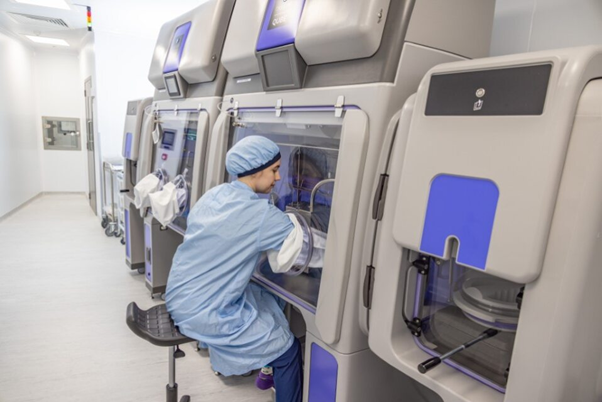The Transformative Power of Process Intensification and Advanced Analytics in Viral Vector Manufacturing

The biopharmaceutical industry is at a critical time point, with gene therapies promising revolutionary treatments for a myriad of diseases. However, the sustainable and cost-effective manufacturing of viral vector products is crucial for the commercial success of these therapies. Given the high raw material costs and production expenses associated with these complex biological products, enhancing the efficiency of manufacturing processes is a necessity. This efficiency is vital for reducing costs and accelerating the development timeline, from regulatory approval to clinical trials and eventual commercialization.
The manufacturing of viral vectors is packed with complexity and extended processing times, presenting significant challenges that demand precise control to ensure the production of safe, efficient, and high-quality drug products. To navigate these complexities, the industry is turning to state-of-the-art technologies and strategies that span process intensification, automation, and real-time analytics. The ultimate aim is to refine production, boost scalability, and reduce costs, all while maintaining product quality and adhering to strict regulatory standards.
Embracing Process Intensification
Process intensification stands out as a pivotal strategy in viral vector manufacturing for gene therapies. This approach leverages advanced technologies to refine the production workflow, including Alternating Tangential Flow (ATF) Systems, Tangential Flow Filtration (TFF) Systems, Acoustic Settlers, Harvest Systems with Depth Filtration (e.g., TFDF), Centrifugation-Based Systems, Inclined Settlers, and Membrane-Based Filtration. These technologies are the linchpins of continuous and efficient viral vector production, offering benefits such as enhanced scalability, shorter processing times, and better resource utilization.
Process intensification has proven to be a game-changer in the field of viral vector manufacturing, typically resulting in a several-fold increase in both cell density and viral vector titre across various viruses and vector types. Employing process intensification techniques typically yields several fold enhancements in HEK293 cell densities, alongside a much-enhanced increase in space-time yield (STY) for certain viral vectors when benchmarked against conventional batch processes. This boost in efficiency is particularly notable for Lentiviral vectors, where intensification strategies are anticipated to significantly amplify the number of doses produced per batch. This advancement is crucial for scaling up gene therapy applications, thereby fulfilling the rapidly growing demand for viral vectors in the market.
The Role of In-Line and Real-Time Process Analytical Technologies
In-line and real-time analytics are critical for ensuring product quality, safety, and efficacy throughout the manufacturing process. Cutting-edge analytical technologies like Raman spectroscopy, viable biomass sensor, flow cytometry, mass spectrometry, near-infrared spectroscopy (NIR), and High-Performance Liquid Chromatography (HPLC) provide instant feedback on critical process parameters. These tools enable real-time monitoring, facilitating swift decision-making and adjustments, reducing the risk of batch failures, and optimizing yield.
The need for large quantities of viral vectors for gene therapies introduces further challenges, necessitating not only greater production capacity but also consistent product quality. Technologies such as Polymerase Chain Reaction (PCR), Enzyme-Linked Immunosorbent Assay (ELISA), dynamic light scattering (DLS), and bio-layer interferometry (BLI) are utilized for in-line and real-time analytics, offering vital insights into the production process. These tests are essential for predictive analytics and streamlined validation, leading to a robust manufacturing process capable of quick adjustments to maintain product quality.
Navigating Challenges and Looking Ahead
While these advanced technologies offer immense potential benefits, they also come with their own set of challenges, including the need for process optimization, scalability issues, and the complexity of maintaining critical process parameters. Integrating these technologies necessitates careful consideration and adaptation to the specific manufacturing context.
As we look to the future, the bioprocessing landscape, including viral vector manufacturing, is undergoing a transformative evolution. The integration of continuous processing, in-line analytics, Bioprocessing 4.0 and beyond, and process intensification is reshaping the industry. Automation, robotics, and artificial intelligence (AI) are key to optimizing processes, enhancing efficiency, and bolstering quality control. The industry is set to capitalize on single-use systems, advanced cell retention, and real-time analytics to cater to the increasing demand for gene therapies. These technological advancements will centralize the role of quality and safety standards while promoting efficient, sustainable, and cost-effective production. Coupled with carbon-neutral practices and waste recycling, these developments signify a shift towards a more streamlined and environmentally conscious future for bioprocessing in the biopharmaceutical sector.
Author: Dr Sujith Sebastian, Viral Vector Hub Manager at NHS Blood and Transplant’s CBC:
For more information or enquires about CBC supporting your plasmid / viral vector manufacturing: Visit CBC’s website, or contact
To find out more about the BIA: visit their website.